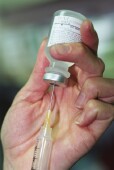
THURSDAY, Feb. 6, 2014 (HealthDay News) — Many U.S. adults are skipping recommended vaccinations that could protect them from serious or life-threatening diseases, according to figures released by federal health officials Thursday.
Modest increases were seen for Tdap vaccinations, which prevent whooping cough, from 2011 to 2012, according to the report from the U.S. Centers for Disease Control and Prevention. More seniors also got vaccinated against shingles, while HPV vaccinations picked up slightly among young women hoping to avoid cervical cancer.
However, Americans aren’t taking full advantage of other routinely recommended vaccines, including those for pneumonia and hepatitis, the CDC said in its Feb. 7 issue of the Morbidity and Mortality Weekly Report.
Vaccination rates for diseases other than flu are well below target levels, and troubling racial/ethnic disparities persist, with whites more likely than blacks and Hispanics to have coverage, the agency said. Flu vaccine rates are published separately.
The data in the report came from the 2012 National Health Interview Survey, which includes a nationally representative sample of the U.S. population.
Coverage for most adult vaccines remains “depressingly low,” said Dr. Len Horovitz, a pulmonary specialist at Lenox Hill Hospital in New York City. “This is a discussion I have daily with patients, who see vaccination recommendations posted in the examination room.”
Patients have a myriad of reasons to refuse the vaccines, Horovitz noted. “Mythology surrounding vaccination is the greatest obstacle,” he said. “In spite of all the press about the rise of whooping cough, for instance, patients still may refuse vaccination.”
Those “myths” include fears that vaccines might cause autism, a concern that has been widely discredited, or lead to illness or severe reactions.
To boost vaccination rates, the CDC said health care providers should review adult patients’ vaccination histories and offer needed vaccines at routine visits. Reminder-recall systems might help in this regard, the agency added. Also needed: publicity about the benefits of vaccines and expanded access to vaccination, the agency said.
“Improvement in adult vaccination is needed to reduce the health consequences of vaccine-preventable diseases among adults,” according to the CDC. Equally important is Tdap vaccination during pregnancy to prevent pertussis (whooping cough) in babies, the agency said. Anyone in close contact with a baby should also be vaccinated against pertussis, which can be deadly for infants. During 2012, nearly 50,000 cases of pertussis were reported to the CDC.
Dr. Debra Spicehandler, an infectious diseases expert at Northern Westchester Hospital in Mount Kisco, N.Y., agreed greater awareness of the benefits of vaccination is critical.
“Vaccinations are mostly likely low in the healthy adult population who do not regularly seek health care and who do not have underlying diseases,” Spicehandler said. “Nationwide campaigns to focus on all adults should be started.”
Spicehandler added a reminder about another important vaccine, the flu vaccine. “It is still not too late to be vaccinated for protection against influenza this season. Rates of active disease are peaking now,” she said. “Early campaigns focused on healthy adults as well as adults with underlying diseases should be done next season.”
Other highlights of the CDC report include:
Pneumonia: Overall, 20 percent of high-risk adults received this vaccination in 2012, about the same number as in 2011. Among adults 65 and older, 60 percent were vaccinated overall.
Tetanus: About 64 percent of adults aged 19 to 64 received some tetanus-containing vaccine in the previous 10 years — about the same as the previous year.
Tdap: Coverage against diphtheria, pertussis and tetanus increased modestly to nearly 16 percent, but in homes with infants under 1 year, coverage was almost 26 percent, similar to the prior year.
Hepatitis A: Only 12 percent of adults aged 19 to 49 had full hepatitis A vaccination coverage (at least two doses) in 2012.
Hepatitis B: About 35 percent of U.S. adults aged 19 to 49 had the recommended three or more doses of hepatitis B vaccine, much the same as in 2011.
Herpes Zoster: Twenty percent of adults age 60 and older received this vaccine to protect against shingles, up from fewer than 16 percent in 2011.
HPV: Almost 35 percent of women aged 19 to 26 received one or more doses of this vaccine, which protects against cervical cancer, up from about 30 percent the year before. About 2 percent of males in this age group got the vaccine, similar to the 2011 number.
Overall, adult vaccination rates are discouraging, health officials said. “These data indicate little progress was made in improving adult coverage in the past year and highlight the need for continuing efforts to increase adult vaccination coverage,” said the CDC.
More information
The U.S. Centers for Disease Control and Prevention outlines the adult vaccines you need.
Copyright © 2025 HealthDay. All rights reserved.

